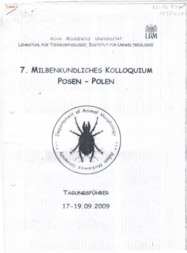Electron microscopic evidences that Citrus leprosis virus, cytoplasmic type (CiLV-C) only circulates in the vector Brevipalpus phoenicis (Acari: Tenuipalpidae) while other nuclear type Brevipalpus transmitted viruses do replicate.
Electron microscopic evidences that Citrus leprosis virus, cytoplasmic type (CiLV-C) only circulates in the vector Brevipalpus phoenicis (Acari: Tenuipalpidae) while other nuclear type Brevipalpus transmitted viruses do replicate.
Autoria: KITAJIMA, E. W.; CALEGARIO, R. F.; FREITAS-ASTUA, J.; ALBERTI, G.
Resumo: Electron microscopic (EM) examination of Brevipalpus phoenicis (Acari: Tenuipalpidae) colonizing Citrus leprosis virus, cytoplasmic type (CiLV-C)-infected sweet orange plants permitted the detection of bacilliform, virus-like particles only between membrane of adjacent cells in the vicinity of the prosomal gland complex and the midgut. The viral nature of these particles was assessed by immunolocalization using anti-CiLV-C capsid proteins. To explain the viral route from the midgut lumen to the duct of the prosomal gland complex two possibilities were considered: (a) intracellular, in which viral particles could be endo- and exocyted in the epithelium of the midgut and prosomal gland complex. (b) Paracellular, by which virions could pass through epithelial cell junctions in a process resembling diapedesis of leucocytes from the capilary vessels in vertebrates. Virions could be transported from midgut to the prosomal glands by a flux induced by the mite movement. Since no virions were ever found within cells. were favor the paracellar route. Also, because we could not detect the characteristic electron dense and vacuolated viroplasma in the mite tissues, we believe that CiLV-C does not multiply en the vector, just circulating in the mite body. Other biological and molecular evidences are in line with this thought. On the other hand, EM observations on several other Brevipalpus-transmitted viruses (BTV) of the nuclear type (nuclear viroplasm) as Coffee ringspot virus (CoRSV). Clerodendrum chlorotic spot virus (CICSV), citrus leprosis virus-nuclear type (CiLV-N) and Orchid fleck virus (OFV) revealed the presence of the rod-shaped virus-like particles in the nucleus and cytoplasm, and the lypical electron lucent nuclear viroplasm in the cells of the epithelium of the midgut and of the prosomal gland complex, as it occurs in infected leaf cells. The detection of the viroplasm strongly suggests that these viruses multiply in some tissues of the mite vector (B. phoenicis for CoRSV, CICSV, CiLV-N) and B. califomicus, for OFV).
Ano de publicação: 2009
Tipo de publicação: Resumo em anais e proceedings
Unidade: Embrapa Mandioca e Fruticultura
Palavras-chave: Brevipalpus Phoenicis, Vírus
Observações
1 - Por padrão são exibidas publicações dos últimos 20 anos. Para encontrar publicações mais antigas, configure o filtro ano de publicação, colocando o ano a partir do qual você deseja encontrar publicações. O filtro está na coluna da esquerda na busca acima.
2 - Para ler algumas publicações da Embrapa (apenas as que estão em formato ePub), é necessário ter, no celular ou computador, um desses softwares gratuitos. Sistemas Android: Google Play Livros; IOS: iBooks; Windows e Linux: software Calibre.
Acesse outras publicações
Acesse a Base de Dados da Pesquisa Agropecuária (BDPA) para consultar o acervo completo das bibliotecas da Embrapa.

